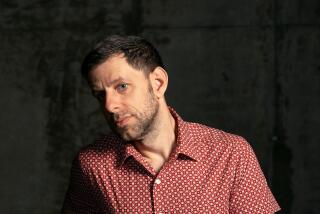JOSE LIMON DANCERS: KEEPING TRADITION ALIVE
Jose Limon Dance Company wanted to do more than survive the death of its founder-director in 1972. It set out to regenerate the whole Limon-Doris Humphrey tradition of creating forceful dance drama, says current company artistic director Carla Maxwell.
“We’re not a museum,” Maxwell, 41, said in a recent phone interview from New York. “We respect and honor the legacy we have, but we also feel the responsibility to keep it growing.”
So the company cast a wide net, reaching out as far as Germany to incorporate elements of its strong Expressionistic dance tradition. For example, Lutz Forster, a member of Pina Bausch’s Wuppertal Tanztheater for almost a decade, became company associate artistic director in 1984. Also, works by contemporary German choreographers began entering the repertory.
An example is Susanne Linke’s “Also, Egmont, Bitte,” which will be seen on the company’s program at El Camino College on Friday and at UC Irvine on Saturday. Both programs also will include Limon’s “A Choreographic Offering” and “There Is a Time.”
Maxwell described Linke’s work, set to taped rehearsals of Beethoven’s “Egmont” Overture, as drawing a “parallel between a rehearsal situation and real human experiences.” But she didn’t want to describe the work further because “I don’t want to give the piece away.”
Maxwell believes, however, that the German connection has been overemphasized.
“Dramatic dance has always been something we’ve fought for, even in (Limon’s) lifetime,” she said. “The whole German connection was an avenue that got overplayed. People love pigeonholing things so that they can categorize it. Actually, we have lots of alternatives and are pursuing them as well.”
Maxwell mentioned Anna Sokolow, who will give the premiere of a work for the Limon company this summer. She also mentioned Meredith Monk, but would not disclose the names of other artists with whom negotiations are pending.
“Our repertory is quite broad,” she said. “Out of 12 works we presented on our latest New York season, only three were by Limon.”
In fact, the widening repertory has led the company to change its name to simply the Limon Dance Company, she said.
Further, Forster returned to Germany last year. Maxwell said that the parting was “not acrimonious. He will continue to be a guest with us, but not on this tour.”
Maxwell, who joined the company in 1965 and became artistic director in 1978, acknowledged that the company has been criticized for seeming out-of-step with postmodern dance trends.
“There was a time, if dance had a beginning, middle or end, you were considered old-fashioned,” she recalled. “Then came chance choreography or whatever. That gets very metaphysical. We’re not.
“We believe that we have responsibility as artists to communicate with people. Obviously we want it (our dance) to be beautiful. But we believe that as artists we have a function to try to reach people’s emotions. That is the kind of dance theater we represent.”
The subject seemed to make Maxwell’s blood pressure rise a bit.
“Am I sounding a little adamant? That’s because I’m trying to make a distinction as to what we are. We’re representative of mainstream modern dance--everything that the postmoderns don’t cover. Even the names, ‘postmodern,’ ‘next wave,’ have no meaning any more. They were thought up as advertising and promotional titles and aren’t necessarily what people do. It’s been a struggle to have people accept us for what we are.”
She believes that fertile exchange of ideas with her European counterparts is still possible, but sees it as a two-way street.
“In Europe, they have a strong theater tradition,” she said. “But they’re also very heavily into a production-oriented thing, too. They get carried away with that: the idea that more and more is better. But there is still a lot to exchange about how to express ideas on stage.
“Very simple statements are the lasting ones. They’re the hardest to make and to dance, but they have the most power. People are understanding that now.”
More to Read
The biggest entertainment stories
Get our big stories about Hollywood, film, television, music, arts, culture and more right in your inbox as soon as they publish.
You may occasionally receive promotional content from the Los Angeles Times.










